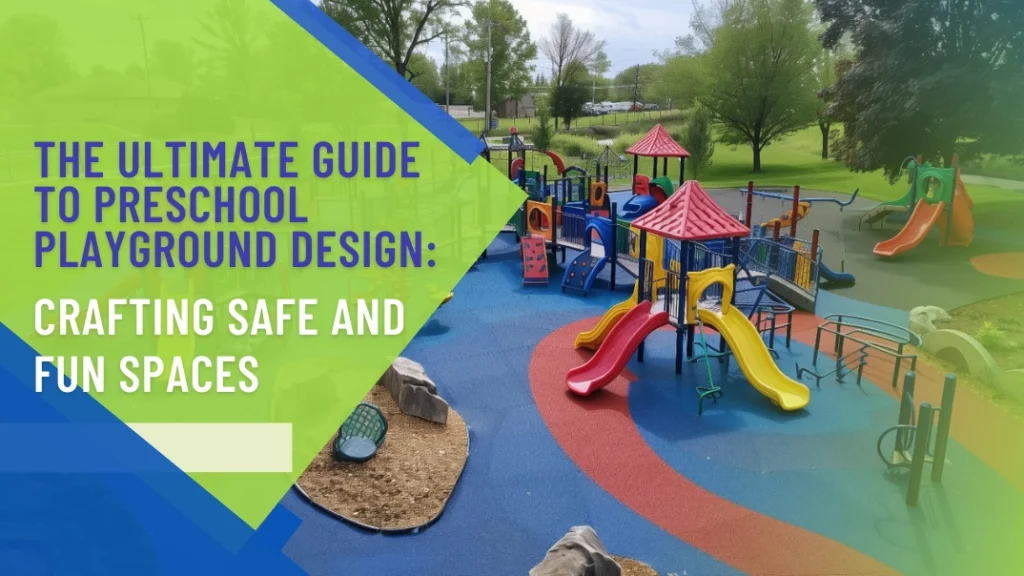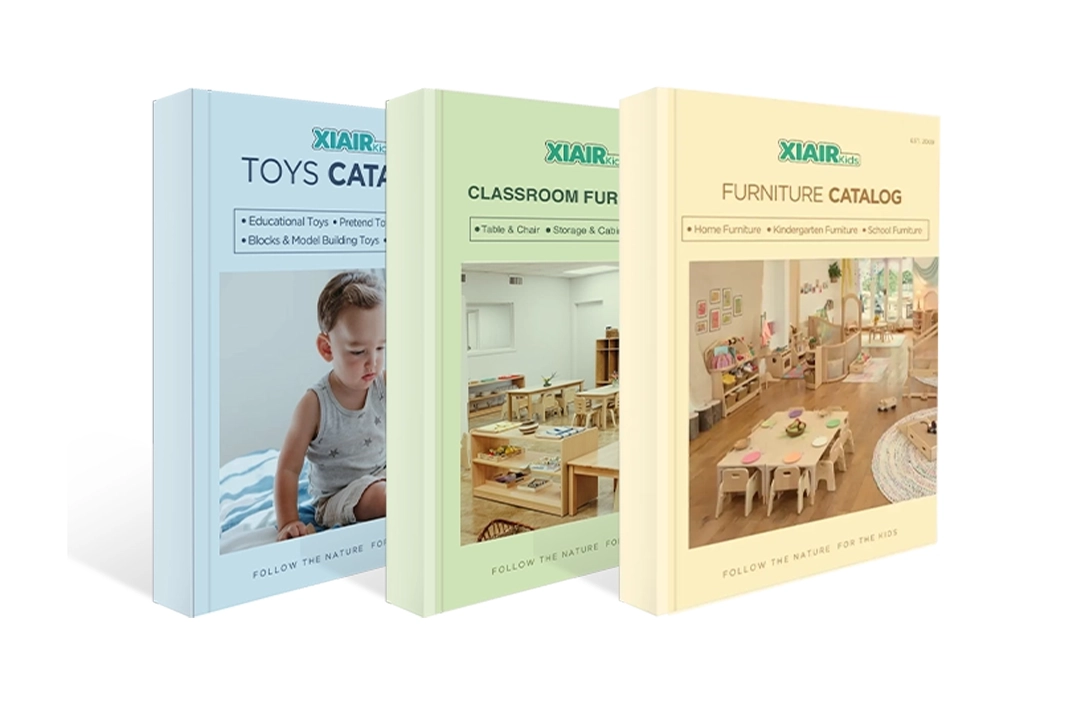Designing the ideal playground for preschoolers is an exciting and significant responsibility. Preschool playground design goes beyond simply arranging swings, slides, and climbing structures. It’s about creating a dynamic environment where young children can engage in play that nurtures their physical, social, and cognitive development. A suitable playground can become vital to a child’s early education, allowing them to explore, imagine, and learn through play.
However, designing such a space is not without its challenges. The layout, choice of equipment, and safety considerations must all be carefully balanced to create a fun and secure space. A well-designed playground should cater to the diverse needs of all children, ensuring that every child, regardless of ability, can participate in and enjoy the activities offered. This involves thoughtful planning and understanding preschool-aged children’s developmental stages and needs.
I’ll explain everything you need to know about preschool playground design in this guide. We’ll explore the importance of creating a safe and stimulating environment, how to choose the right equipment, and the many benefits of free play for young children. By understanding these essential elements, you can design a playground that meets safety standards and enriches the children’s lives.
Creating the perfect preschool playground is about more than just aesthetics. It’s about designing a space where children feel safe, valued, and inspired to explore their world. From selecting age-appropriate play structures to incorporating elements that encourage social interaction, every detail in preschool playground design plays a crucial role in shaping a child’s early learning experiences.
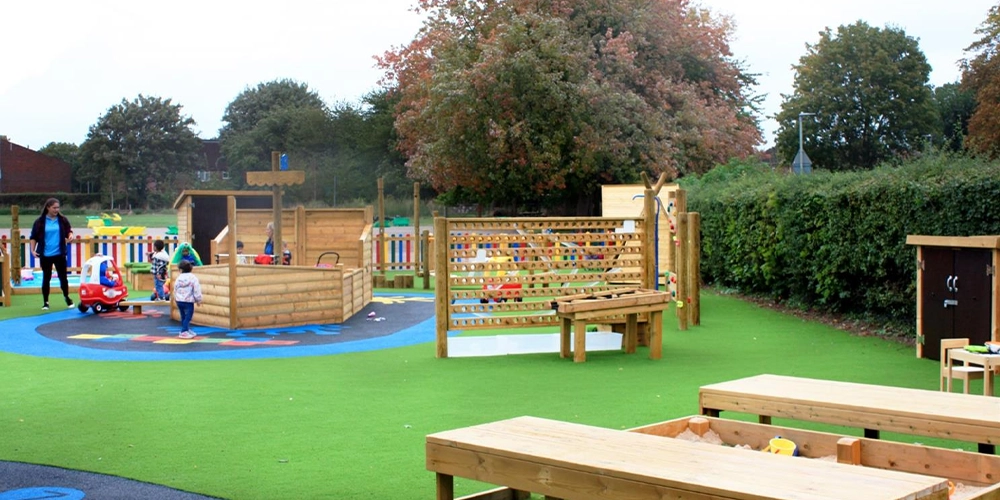
Benefits of Free Play for Developing Children
Free play is a fundamental aspect of early childhood development, and a well-designed preschool playground can significantly enhance this experience. Preschool playground design is crucial in providing children with the space and resources to engage in free play, which benefits their development in multiple ways.
사회 개발
One of the most important benefits of free play is its impact on social development. When children engage in unstructured play, they naturally interact with their peers, learning essential social skills such as communication, cooperation, and empathy. Preschool playgrounds with open spaces and various play zones encourage children to form friendships, share toys, and collaborate on imaginative games. These interactions are critical for developing social competence and building relationships that can last a lifetime.
인지 발달
Free play is also a powerful tool for 인지 발달. As children explore their environment, solve problems, and create games, they develop critical thinking and decision-making skills. A well-thought-out preschool playground design includes elements that stimulate curiosity and challenge a child’s intellect, such as activity panels, interactive play structures, and pretend play equipment. These features encourage children to think creatively, experiment with cause and effect, and engage in complex role-playing scenarios, all essential for cognitive growth.
신체 발달
신체 발달 is another significant benefit of free play. When children are active on the playground, they develop gross motor skills, coordination, and overall physical fitness. A well-designed preschool playground provides a variety of equipment that encourages climbing, swinging, running, and balancing. These fun activities help children build muscle strength, improve balance, and enhance their physical health. Additionally, playgrounds with varied terrain, such as hills, tunnels, and climbing structures, can further challenge children’s physical abilities, promoting endurance and resilience.
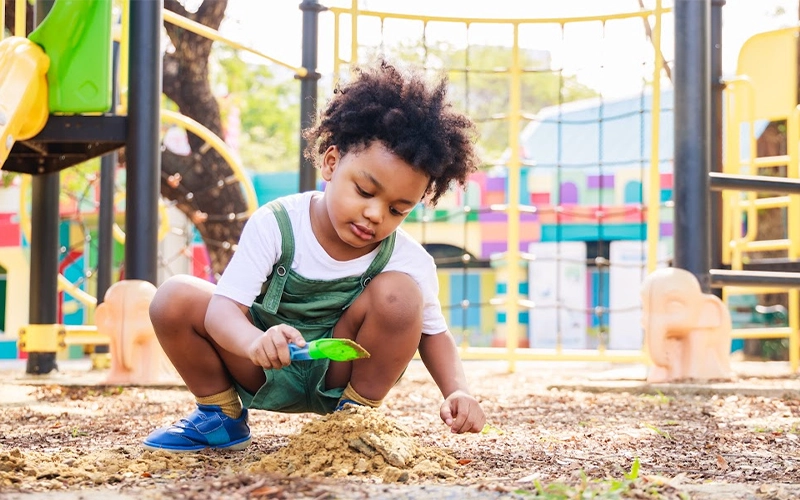
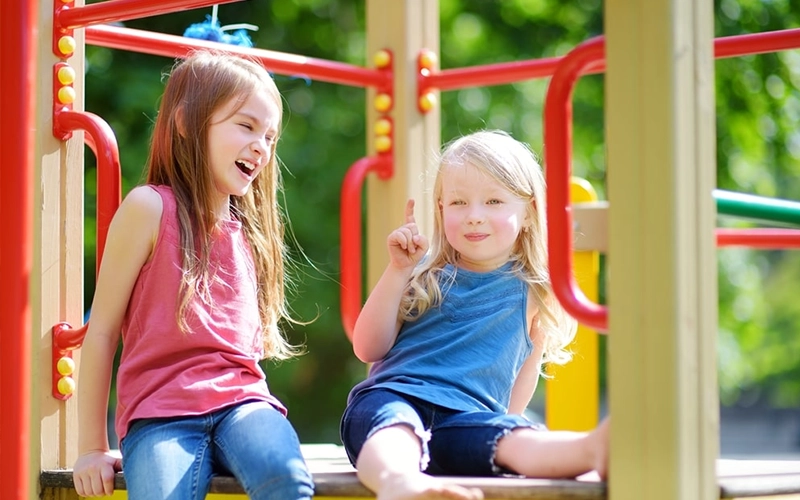
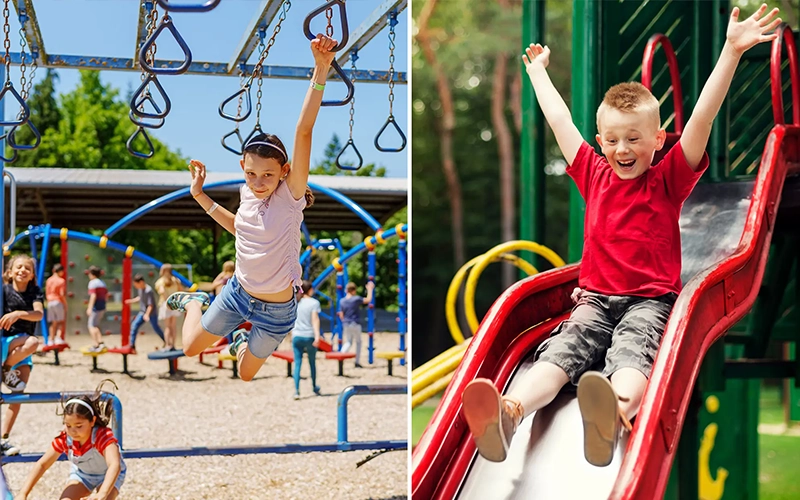
Creating the Perfect Preschool Playground Design
Creating an ideal preschool playground involves more than just picking out equipment and placing it in an open space. A successful preschool playground design requires careful consideration of several factors to ensure that the playground is safe, engaging, and suitable for the developmental needs of young children. Below are the key steps to consider when designing a preschool playground.
Understanding Preschool Playground Layout Design Principles
A well-thought-out preschool playground layout goes beyond aesthetics. It directly affects how children explore, interact, and play. Before installing any equipment, it’s essential to look at the space’s size, shape, surface material, sun exposure, and surrounding features. Good design starts with understanding the environment you’re working with.
The first step in any design for a preschool playground layout process should be a simple sketch that divides the space into core play zones. These typically include:
- Active play zones for running, climbing, and gross motor activities
- Quiet areas for reading, drawing, or resting
- Social spaces for small group interaction
- Sensory or nature-based zones with sand, water, or natural elements
Each zone should be clearly defined, not only physically (e.g., using landscaping, textures, or soft dividers) but also in how children experience them. The transition between zones should be smooth and intuitive, allowing children to flow from one type of activity to another without abrupt interruptions or safety risks.
One of the most critical layout principles is visibility. Teachers and caregivers need to see all children at all times. Avoid installing tall or bulky equipment in the center of the playground that may block lines of sight. Instead, position climbing structures or enclosed spaces along the edges so staff can supervise more easily.
Another design factor to consider is the separation of age groups. Younger children benefit from ground-level features like low slides or crawl tunnels, while older preschoolers can handle more complex structures. Mixing the two in one area may cause safety issues or limit access for some children.
Safe traffic flow is another essential principle. Children should not have to cross high-energy zones like swing paths or running areas to reach other playground parts. Use rubberized paths or textured walkways to guide movement in predictable, safe directions.
Accessibility is equally essential. Follow ADA guidelines to ensure that paths are wide enough, ramps are included, and every child can engage with equipment regardless of mobility or ability.
Designing a strong preschool playground layout isn’t just about placing fun items on a field. It requires understanding how space influences play, safety, and supervision. A design that respects children’s movement, attention spans, and social behavior creates a more effective and inclusive play experience.
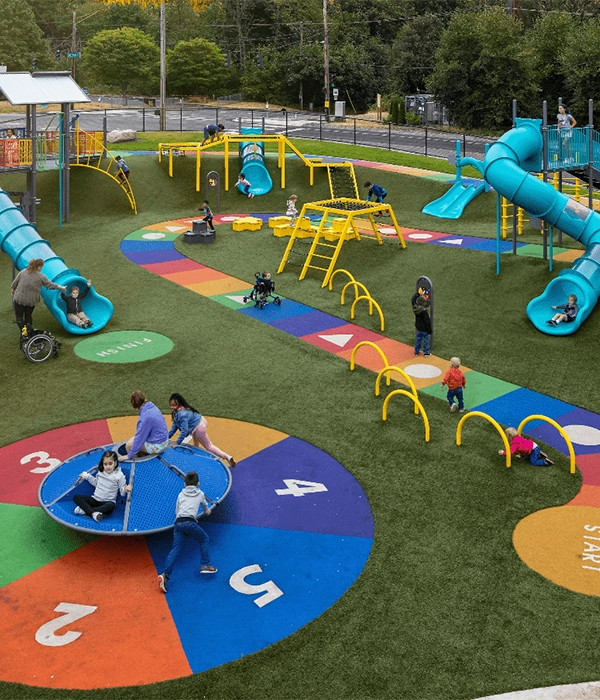
1. Consider Capacity
The first step in preschool playground design is to consider the number of children using the space. Understanding the playground’s capacity will help you determine the amount and type of equipment needed to accommodate all children comfortably. Overcrowded playgrounds can lead to accidents and reduce the quality of the play experience. Therefore, it’s essential to design a playground that provides ample space for children to move freely, explore different activities, and engage with their peers without feeling confined.
2. Choose the Play Theme
Selecting a theme is essential to preschool playground design as it sets the tone for the entire space. A well-chosen theme can ignite children’s imaginations and make playtime more enjoyable. Whether it’s a nature-inspired theme with wooden elements and greenery or a space adventure with rockets and planets, it should be engaging and appropriate for preschool-aged children. Themed playgrounds make the space visually appealing and provide a narrative that children can build their play around, enhancing their creative thinking and storytelling skills.
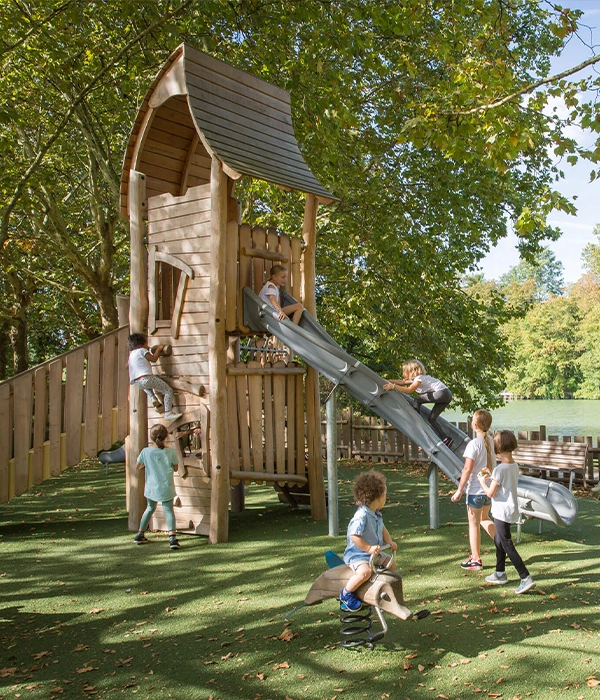
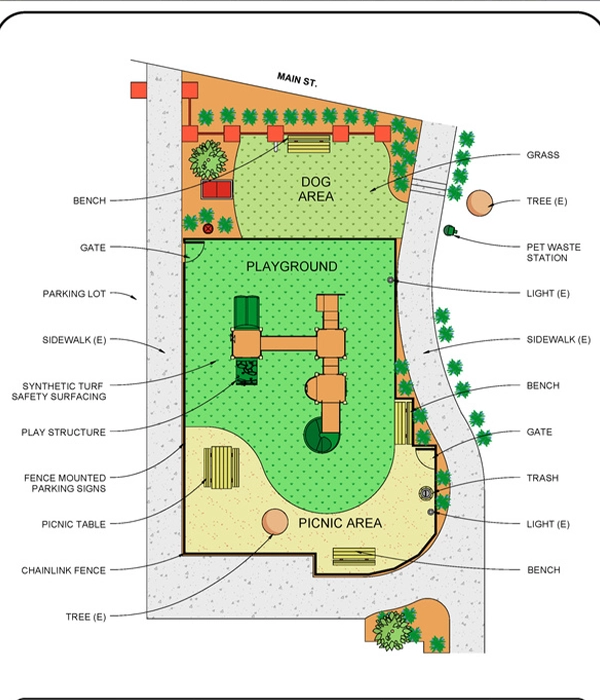
3. Plan Your Playground Layout
The layout of a preschool playground is critical to its functionality and safety. A well-planned preschool playground design should include distinct areas for activities such as active play, quiet play, and social interaction. For example, placing climbing structures away from swings can prevent accidents, while positioning benches near play areas allows caregivers to monitor children easily. The layout should also include clear pathways enabling children to move safely from one area to another without obstruction. Additionally, considering the flow of movement within the playground ensures that children can navigate the space independently and confidently.
4. Choose Age-Appropriate Equipment
Choosing the right equipment is essential in preschool playground design. The equipment should be designed for the age group using the playground, ensuring it is safe, manageable, and developmentally appropriate. This means selecting equipment with lower heights, softer surfaces, and features promoting preschoolers’ motor skill development. Age-appropriate equipment might include low slides, small climbing walls, and sandbox areas. By choosing equipment that matches the abilities of young children, you create a safer and more enjoyable play environment.

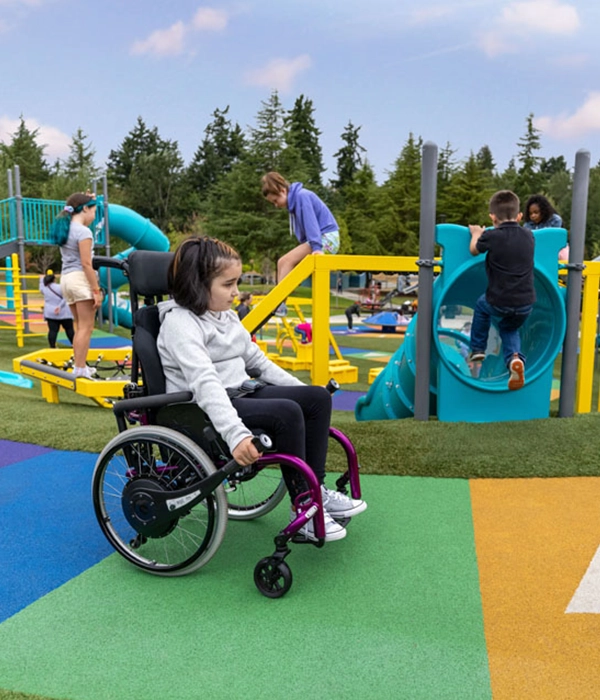
5. Make It Inclusive
Inclusivity is a crucial consideration in modern preschool playground design. Regardless of their physical abilities, all children can enjoy a great playground. To achieve this, include elements like ramps for wheelchair access, sensory play panels, and swings with safety harnesses. Inclusive playgrounds also feature wide paths and play areas that allow children with mobility aids to move around freely. Making the playground inclusive ensures that every child can participate in play, which is essential for their social and emotional development.
Creating the perfect preschool playground design involves a deep understanding of the needs and abilities of young children. By focusing on capacity, theme, layout, age-appropriate equipment, and inclusivity, you can design a playground that provides a safe play environment and supports the children’s overall development.
Creating Your Playground With a Variety of Play Equipment
Variety is vital in preschool playground design. A playground should offer a range of equipment that caters to different types of play, ensuring that all children find something that interests them and helps their development. Diverse play equipment keeps children engaged and supports their physical, social, cognitive, and emotional growth. Here’s a closer look at the different types of play equipment that should be included in a well-rounded preschool playground.
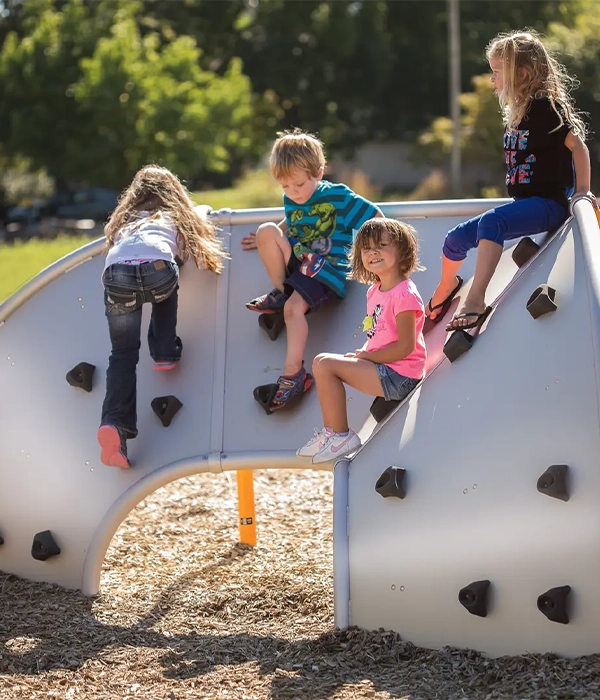
등반 구조물
Climbing structures are an essential component of any preschool playground design. They help develop a child’s strength, coordination, and problem-solving skills. For preschoolers, climbing structures should be low to the ground and designed with safety in mind. Features like wide steps, handrails, and soft surfaces underneath can prevent injuries while still offering a challenge. Climbing structures encourage imaginative play, as children often turn them into mountains, castles, or spaceships during their adventures.
슬라이드
슬라이드 are a favorite among young children and are essential to preschool playground design. They provide an exhilarating experience that helps children develop balance and coordination. When choosing slides for preschoolers, selecting ones that are appropriately sized, with gentle slopes and secure sides to prevent falls, is crucial. Adding multiple slides with varying heights and lengths can cater to different comfort levels, ensuring all children feel confident and excited about using them.
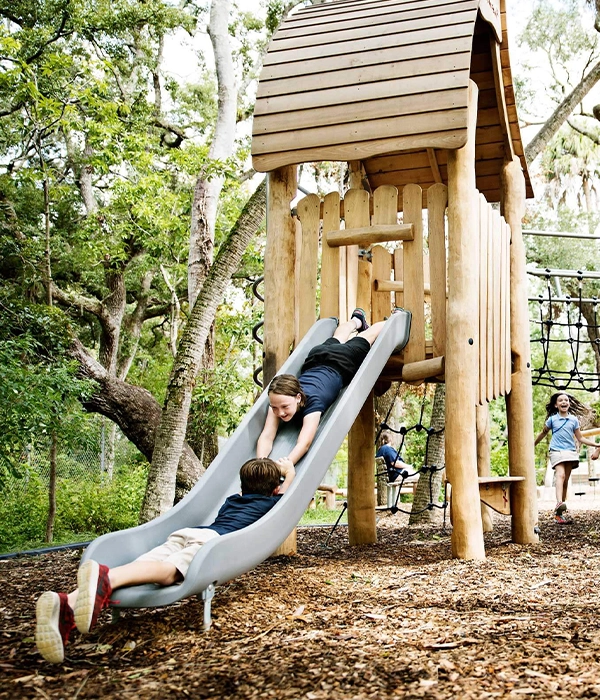
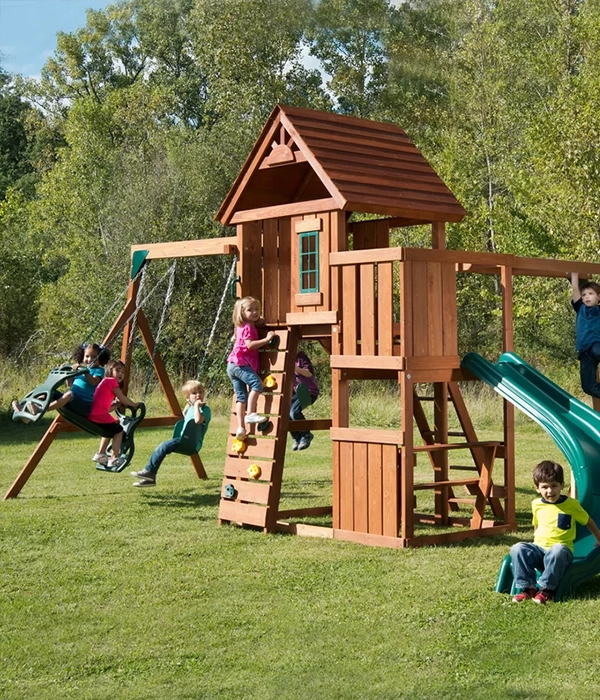
스윙
Swings are another staple of preschool playground design. They offer children the thrill of movement while helping them develop balance and core strength. For preschool-aged children, bucket swings or swings with safety harnesses are ideal as they provide extra support and security. Additionally, incorporating accessible swings allows children of all abilities to enjoy this timeless playground feature. Swings also encourage social interaction, as children often take turns and engage in conversations while waiting for their turn.
Riding Equipment
Riding equipment, such as tricycles, scooters, and rocking horses, is a fantastic way to promote physical activity and coordination in preschoolers. These types of equipment allow children to practice balance, improve motor skills, and gain confidence in their physical abilities. In preschool playground design, it’s essential to include smooth, flat surfaces or designated paths where children can safely ride and explore. Various riding options ensure that children with different preferences and skill levels can participate.
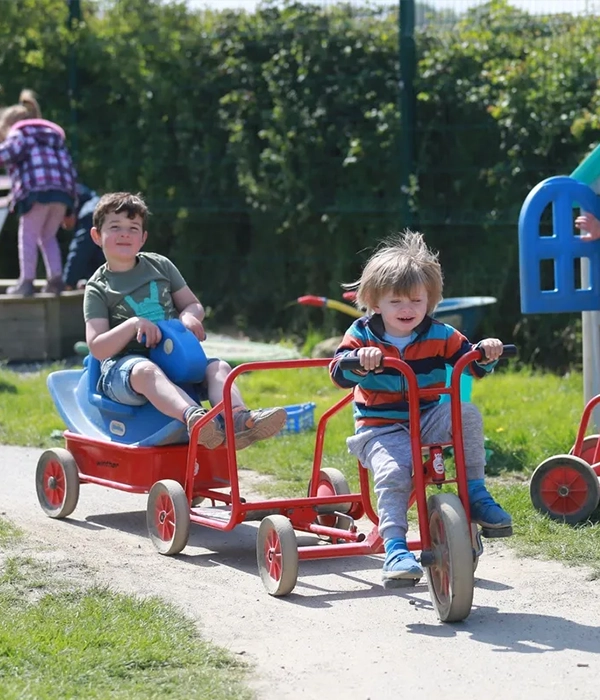

Activity Panels
Activity panels are interactive elements easily integrated into preschool playground design. These panels often include puzzles, mazes, musical instruments, and other sensory activities that engage children’s minds and encourage fine motor skills development. Activity panels are particularly beneficial for quieter play and can be placed where children can focus and explore at their own pace. They are also a great way to incorporate educational elements into the playground, making learning fun and hands-on.
Pretend Play Equipment
Pretend play is a vital aspect of early childhood development, and incorporating pretend play equipment into preschool playground design can significantly enhance the play experience. Playhouses, kitchens, grocery stores, and other themed structures allow children to engage in imaginative play, which helps them understand the world around them and develop social skills. These setups encourage children to create narratives, role-play different scenarios, and interact meaningfully with their peers.
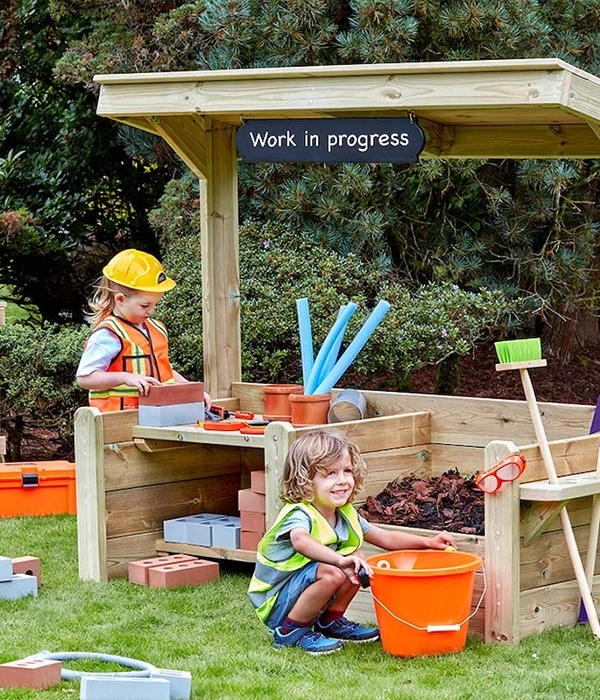
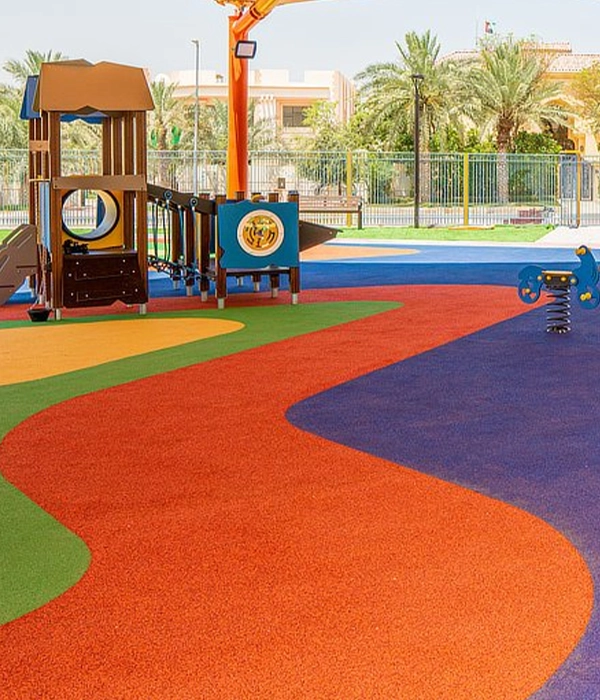
Safety Surfaces
No playground is complete without proper safety surfaces, a critical consideration in preschool playground design. Safety surfaces, such as rubber mats, mulch, or sand, are essential for cushioning falls and preventing injuries. These surfaces should be installed under all play equipment and where children are likely to run, jump, or climb. When choosing safety surfaces, selecting materials that are durable, easy to maintain, and suitable for the climate in which the playground is located is essential. Proper safety surfacing ensures that children can play freely without the risk of severe injury and gives parents and caregivers peace of mind.
당신에게 딱 맞는 교실을 클릭 한 번으로 만나보세요!
Safety Considerations for Preschool Playground
Safety is the cornerstone of any good preschool playground design. While creating a fun and engaging environment is essential, ensuring that the playground is safe for all children is the top priority. Here are some important safety considerations to consider when designing a preschool playground.
- 올바른 위치를 선택하세요: The playground location is the first safety consideration in preschool playground design. It should be situated in an area that is easily visible and accessible, away from traffic, bodies of water, or other hazards. The location should also have good drainage to prevent water from pooling, which can create slippery surfaces and increase the risk of falls. Additionally, the playground should be close to the school or daycare center, allowing for easy supervision by teachers and caregivers.
- Find the Right Terrain: The terrain on which the playground is built plays a significant role in its safety. Ideally, the ground should be flat or have a gentle slope, with no sharp inclines or uneven surfaces that could cause children to trip or fall. If the playground is built on a natural surface, removing any rocks, roots, or other obstacles that could pose a hazard is essential. Ensuring the terrain is stable and even is a critical step in preschool playground design.
- Include Shady Spaces: Protecting children from the sun is another important safety consideration in preschool playground design. Including shaded areas, such as trees, awnings, or shade structures, provides children a place to cool down and rest, especially during hot weather. Shaded spaces also protect children from harmful UV rays, reducing the risk of sunburn and heat-related illnesses. By incorporating shade into the playground design, you create a more comfortable and safe environment for play.
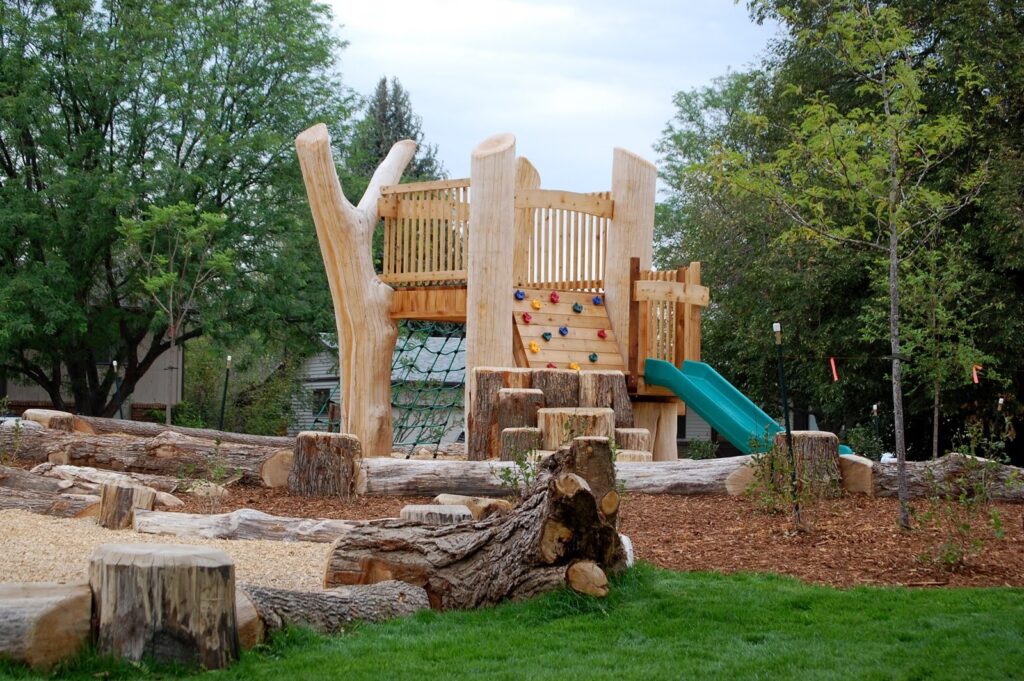

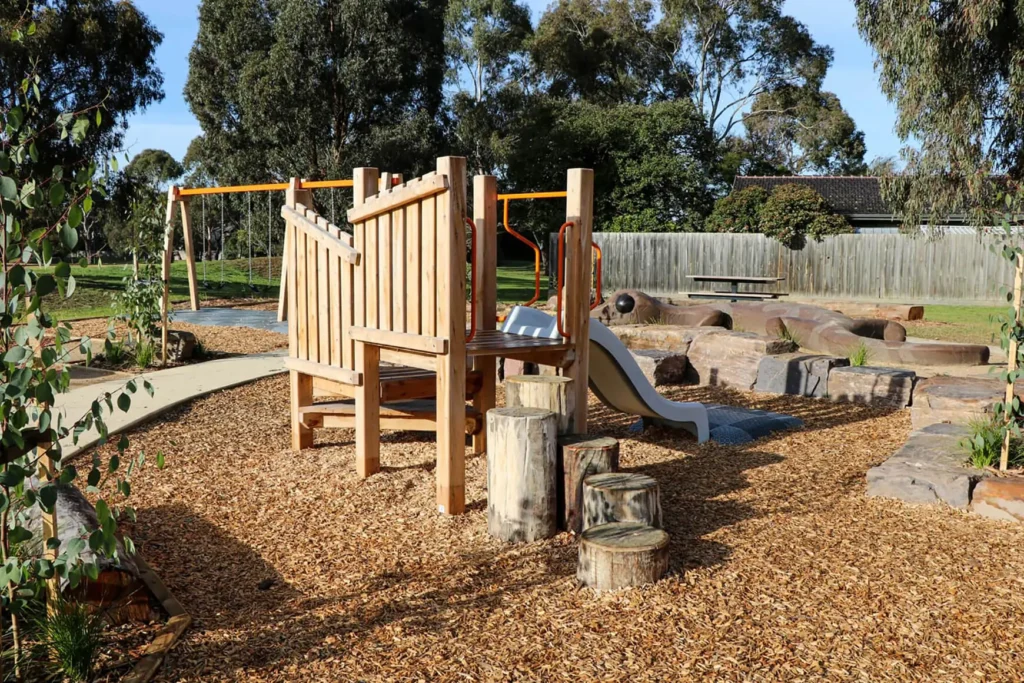
- Choose Appropriate Surfacing: Choosing suitable surfacing is crucial in minimizing injuries from falls, which are the most common playground accidents. Materials like rubber mulch, sand, or engineered wood fibers are often used in preschool playground design because they provide a soft, shock-absorbing surface. It’s essential to ensure the surfacing material is spread evenly and maintained regularly to prevent it from becoming compacted or displaced. Proper surfacing not only helps cushion falls but also reduces the severity of any injuries that do occur.
- Add a Perimeter Fence: A perimeter fence is an important safety feature in preschool playground design. It is a barrier that keeps children safely within the play area and prevents them from wandering off or running into dangerous areas, such as streets or parking lots. The fence should be tall enough to deter climbing and have gates that can be securely latched. Installing a wall also helps control access to the playground, ensuring that only authorized individuals can enter the play area.
- Eliminate Any Hazards: Regularly inspecting the playground for hazards is crucial to maintaining a safe play environment. Choosing durable and resistant to wear and tear equipment and materials in preschool playground design is essential. All equipment should be securely anchored, and any sharp edges, exposed bolts, or loose parts should be addressed immediately. Additionally, ensuring that the playground is free of debris, such as broken glass, trash, or animal waste, is essential for maintaining a clean and safe space for children to play.
In conclusion, a well-designed preschool playground offers a variety of play experiences while prioritizing the safety of the children who use it. By carefully selecting and arranging equipment, incorporating safety features, and regularly maintaining the playground, you can create a space where children can play, learn, and grow in a secure environment.
Creating a preschool playground is not just about building a fun place for children to play; it’s about designing an environment that plays a vital role in their development. A well-thought-out preschool playground design serves as more than just a space for physical activity. It becomes a place where children learn critical social skills, enhance their cognitive abilities, and develop physically in a safe and supportive environment.
The importance of diversity in play equipment cannot be overstated. By incorporating various equipment— from climbing structures and swings to pretend-play areas and activity panels—you cater to young children’s different interests and developmental needs. Each type of equipment contributes uniquely to a child’s growth, whether fostering creativity, improving coordination, or encouraging social interaction. A diverse playground ensures that every child, regardless of their preferences or abilities, finds something that engages them and supports their overall development.
Safety is the cornerstone of effective preschool playground design. Every element, from the selection of age-appropriate equipment to the choice of safety surfaces and the inclusion of perimeter fencing, must be carefully planned to create a secure environment where children can explore and play without unnecessary risks. Attention to safety does not diminish the fun; it enhances the overall play experience by allowing children to engage fully in their activities with confidence and peace of mind.
Moreover, a successful playground design must be inclusive, ensuring that all children, regardless of their physical or cognitive abilities, have access to the joys and benefits of play. Incorporating features like ramps, accessible swings, and sensory play areas ensures no child is left out, fostering a sense of belonging and community among the children.
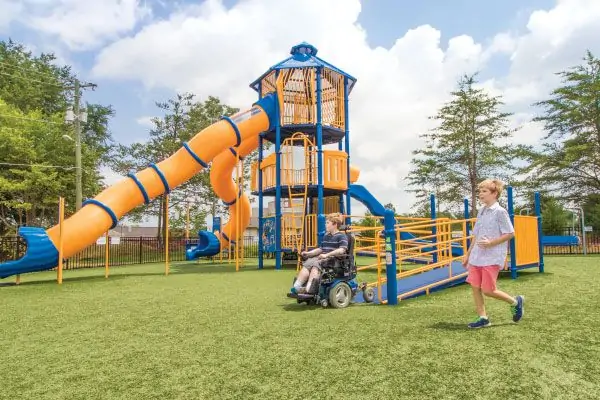

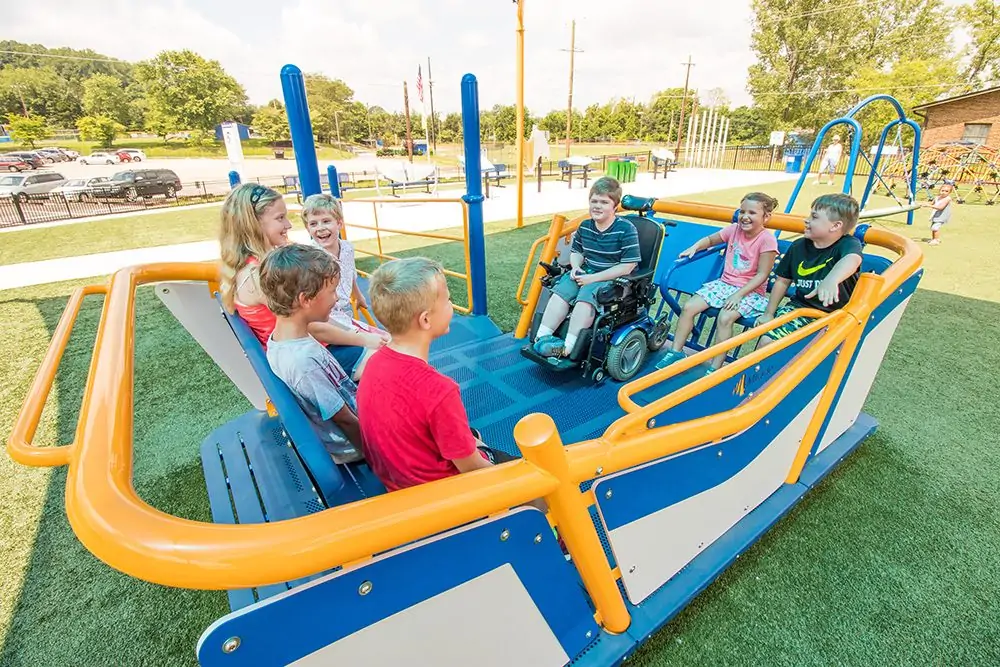
Outdoor Design Strategies for Preschool Playground Layouts
Outdoor spaces allow children to move, explore, and connect with nature. However, to get the most from an outdoor area, a strong preschool playground design must consider more than just equipment—it must be grounded in actual environmental conditions and functional planning.
Below are key strategies that ensure your outdoor layout is safe, adaptable, and engaging year-round.
Site Analysis: What to Observe and Measure
Begin with a fundamental site analysis before drawing layouts or selecting equipment. Even slight differences in the terrain can impact design decisions.
Things to assess on site:
- Sun exposure throughout the day (where shade is, where it’s needed)
- Wind direction and how it affects specific corners
- Drainage patterns after rain—do any areas pool water?
- Slope and grade of the land (necessary for ADA access and erosion control)
- Tree coverage, nearby walls, or large structures that impact visibility or safety
Spend at least a full day observing the space at different times. Use chalk or cones to map out zones based on sunlight and shade.
Climate-Based Design Adjustments
Overheated play surfaces are a serious risk in hot climates. Frost and ice create safety issues in cold temperatures. Rain-prone regions struggle with erosion and surface durability.
Design adjustments by climate:
| Climate Type | Key Design Consideration | Suggested Solution |
|---|---|---|
| Hot & Sunny | Overheated surfaces, sun exposure | Shade sails, UV-protected surfacing |
| Rainy | Water pooling, muddy zones | Pervious surfacing, drainage channels |
| Cold/Snowy | Icy buildup, freeze/thaw erosion | Heated paths, slip-resistant mats |
| Windy | Equipment movement, sand or debris issues | Windbreak fencing, tree line planting |
A well-adapted preschool playground design must respond to local weather to remain usable and safe year-round.
Working with Natural Elements
Great outdoor layouts use the land, not fight it. Trees, small slopes, and rocks can become natural play features or help organize zones without extra infrastructure.
Design ideas using natural features:
- Turn a mild slope into a tunnel slide or climbing hill
- Place quiet zones under trees for natural cooling and calm
- Use large rocks or logs as seating, borders, or stepping stations
- Retain low grassy mounds as nature-based rest spots
This creates a more dynamic, sensory-rich playground, reducing the need for heavy construction or expensive equipment.
Outdoor Safety Layout Techniques
Designing for safety doesn’t mean removing fun—it means eliminating avoidable risks through layout decisions.
Key safety layout rules:
- Keep high-speed activities (running, swinging) away from main walking paths
- Allow a minimum of 6 feet of buffer zones around climbing or elevated play
- Avoid placing equipment with moving parts (e.g., swings) near fences or walls
- Use low-planting zones to separate high-use and low-use areas naturally
- Plan all exit/entry points to be within visible supervision lines
A safe preschool playground design should make adult supervision easy and children’s choices predictable.
Drainage and Surfacing: Getting It Right
Even the best design fails if water collects in play zones or surfaces become unusable. Drainage and surfacing choices should always match your climate, usage frequency, and maintenance ability.
Drainage Tips:
- Slight slope (1–2%) across surfaces to move water naturally
- Drainage channels with gravel or piping beneath high-use zones
- Elevated borders around sandboxes or water play to contain overflow
Surface Materials Comparison:
| Surface Type | 장점 | 단점 |
|---|---|---|
| Poured-in-place rubber | Durable, safe, low maintenance | High upfront cost |
| Engineered wood fiber | Natural look, soft, affordable | Needs regular replacement |
| Artificial turf | Clean look, all-weather | Can get hot in full sun |
| Grass/natural ground | Cost-free, sensory value | Muddy, requires frequent care |
Always select surface types based on zone use—climbing needs shock-absorbing surfacing, and quiet areas can use softer natural options.
Planning Supervision Paths and Visibility Zones
Every playground point should be visible from at least one adult standing zone. The layout must support clear, broad sightlines and avoid blind spots.
Layout tips for visibility:
- Place taller structures (like climbers or slides) toward the edges
- Keep center zones low-profile for an open view across the entire yard
- Create staff standing platforms or paths slightly elevated for better angles
- Avoid hiding quiet/sensory zones behind fences, trees, or buildings
A good preschool playground design doesn’t just work for children—it works for the adults keeping them safe.
How to Build Seasonal Adaptability into Outdoor Designs
Outdoor playgrounds should evolve with the seasons. This keeps the space interesting and allows adjustments for comfort, curriculum, and changing student needs.
Design ideas for flexibility:
- Include portable modular items that can be moved or stored
- Use hook-based systems to switch panels or signage easily
- Designate zones for rotating activities like gardening or sensory tubs
- Install weather-proof storage nearby so materials can be changed often
A flexible outdoor space encourages creativity for both teachers and kids.
꿈만 꾸지 말고, 직접 디자인하세요! 맞춤 가구에 대한 니즈를 함께 이야기 나눠요!
Modular Layout Approaches in Preschool Playground Design
Modular layout planning is one of the most flexible strategies in preschool playground design, especially for schools that need to grow, adapt, or refresh their play environments over time. Unlike fixed structures that require permanent installation, modular zones allow for easy rearrangement, replacement, or seasonal rotation—without sacrificing safety or learning value.
This section will explore modular design, how it works in a preschool setting, and what it takes to implement it successfully.
Understanding Modular Design in Preschool Settings
Modular design means creating independent zones or components that can function independently and fit into a larger layout. These zones can be moved, swapped, or rotated without the playground being rebuilt.
Modular vs. Traditional Layout Comparison
| 특징 | Modular Layout | Traditional Fixed Layout |
|---|---|---|
| 유연성 | High – zones can move or change | Low – equipment is permanently installed |
| Setup Cost | Lower upfront; scalable over time | Higher initial investment |
| 유지 | Easy to isolate and replace parts | Full area shutdown may be needed |
| Staff Adaptability | Can fit different teaching goals | Fixed interaction points |
| Long-Term Scalability | Add or remove zones as needed | Hard to reconfigure once built |
Modularity provides unmatched control for preschools with changing class sizes, short leases, or evolving programs.
Core Modules and How to Arrange Them
A clever preschool playground design using modular zones typically includes a mix of activity types, stimulation levels, and social group sizes.
Common Module Types:
- Movement Zone: climbing domes, mini hurdles, balance beams
- Sensory Zone: water tables, sand pits, musical panels
- 크리에이티브 존: Chalk walls, mobile art easels, construction blocks
- Role Play Zone: toy kitchens, puppet theaters, dress-up areas
- 조용한 구역: books, cushions, tents, shade-covered seating
Suggested Layout Patterns:
- Loop Layout: Forms a walking path or circuit; ideal for large yards
- Island Layout: Scattered modules with paths between them
- Cluster Layout: High-interaction zones grouped; quiet zones on perimeter
- Seasonal Rotation: Rotating different sets of modules every few months to support new curriculum
To help children navigate, you can color-code floor zones or use signage, giving the space a sense of rhythm and predictability.
Practical Setup Requirements
Even though modular setups are flexible, they still require thoughtful execution to ensure durability and safety.
Base Surfacing
All modules should rest on a unified surfacing system, like:
- Poured rubber (best for impact zones)
- Synthetic turf (easy to clean)
- Interlocking EVA foam tiles (great for temporary setups)
Anchoring and Boundaries
For safety:
- Use anchor points built into the surface to fix heavier items
- Place rubber bumpers or foam borders to define zone edges
- Use non-slip base pads under light equipment
Avoid placing movable items near drop-offs or fences unless they’re weighted or secured.
Operational Workflow for Teachers and Staff
One of the most significant advantages of modular playgrounds is that they can align with educational planning. However, for teachers and staff to succeed, their day-to-day use must be manageable.
- Plan a rotation calendar for module changes—every 6–8 weeks is ideal
- Assign responsibility zones to staff for set-up and teardown
- Provide storage carts or shelters for modules not in use
- Printed layout reference guides showing where each module should go
This turns the layout into an extension of the teaching plan rather than just a physical space.
Pros and Limitations of Modular Designs
Like any system, modularity comes with trade-offs. Understanding when to use it—and when to avoid it—is part of good design thinking.
When Modular Works Best:
- Changing enrollment size or mixed-age groups
- Shared spaces (e.g., the yard doubles as event space or parking)
- Need for curriculum flexibility
- Budget spread over multiple years
Where It Might Not Be Ideal:
- Steep or uneven terrain that makes module movement unsafe
- Areas with high theft or vandalism risk
- Tiny sites where fixed installations make better use of space
The best preschool playground design often blends modular elements with a few key fixed structures—finding the balance between stability and flexibility.



Common Mistakes to Avoid in Preschool Playground Design
Even with the best intentions, many preschool playground design projects fall short—not because of budget or ambition but because of avoidable planning errors. These mistakes can lead to safety risks, limited play value, poor supervision, or underused space.
Below are some of the most common design mistakes and how to avoid them.
Failing to Understand Children’s Developmental Needs
A playground isn’t just a collection of play equipment. It’s a developmental environment. One of the most frequent design mistakes is selecting features based on visual appeal or current trends rather than how children play and learn.
What Goes Wrong:
- Equipment doesn’t match children’s motor skills or attention span
- Spaces encourage only one type of play (e.g., physical, but not imaginative or social)
- Older preschoolers find the environment boring or “too young.”
How to Avoid It:
- Include a balance of gross motor, fine motor, sensory, and imaginative elements
- Use feedback from early childhood educators during planning
- Provide multi-purpose areas that can evolve as children grow
Overcrowding the Playground
In many playgrounds, equipment is packed too tightly, leaving little room for movement or supervision. More is not always better.
What Goes Wrong:
- Children bump into each other during high-energy play
- Supervisors can’t move between zones easily
- Lines of sight are blocked, increasing the risk of unnoticed conflict or injury
How to Avoid It:
- Follow recommended clearance zones for all equipment
- Leave generous open space between modules or activity zones
- Design with fewer, more purposeful elements instead of cramming in options
Ignoring Supervision and Visibility Needs
One of the most overlooked aspects of preschool playground design is how staff observe and interact with children in the space. A well-equipped yard can still be unsafe if blind spots exist.
What Goes Wrong:
- Equipment creates visual barriers
- Quiet or hidden zones are placed behind structures or in corners
- Teachers must constantly move to supervise different areas
How to Avoid It:
- Use low-profile equipment in the center, taller structures at the edges
- Design paths and zones around adult line-of-sight principles
- Include elevated standing spots or decks for wide-range visibility
Poor Surface Planning and Drainage
The surface under and around play equipment directly impacts safety and usability. Choosing the wrong surface—or failing to plan for water movement—can lead to injury or unusable spaces.
What Goes Wrong:
- Water collects in high-use areas after rain
- Surfaces become slippery, uneven, or unstable
- Inappropriate materials (like gravel or untreated wood chips) increase risk
How to Avoid It:
- Match surfacing to activity type and climate (e.g., rubber under climbers, turf in quiet areas)
- Ensure slopes and drainage channels move water away from play zones
- Budget for maintenance and top-up of loose-fill materials
Using One-Size-Fits-All Equipment
Preschoolers aren’t a uniform group. There’s a huge developmental gap between a 2-year-old and a 5-year-old. Yet many playgrounds install large, “universal” structures that don’t serve either group well.
What Goes Wrong:
- Younger children can’t safely use most features
- Older children get bored quickly
- Teachers have to manage safety concerns constantly
How to Avoid It:
- Design separate zones or equipment clusters by age group
- Offer both ground-level and elevated features
- Include scalable features (e.g., low ramps that become bridges, soft climbing structures)
Neglecting Transitions and Entry/Exit Design
Most playground injuries and crowding issues occur during transitions—drop-off, recess, or cleanup. If entry and exit points aren’t planned carefully, chaos can happen daily.
What Goes Wrong:
- Traffic jams at gates or narrow paths
- Children wander into high-motion areas on arrival
- Staff struggle to move groups efficiently
How to Avoid It:
- Provide multiple, clearly defined entry points if possible
- Place high-energy zones farther from gates and buildings
- Create buffer zones (e.g., open mats, chalk areas) for staging transitions
Failing to Future-Proof the Design
Preschools grow, programs shift, and outdoor spaces must adjust over time. Designing something too rigid can create significant limitations.
What Goes Wrong:
- No space left for new modules or changes
- Equipment becomes outdated or broken and can’t be replaced easily
- Changing age groups or class sizes outgrow the layout
How to Avoid It:
- Leave some open or “expansion” zones
- Use modular equipment where possible
- Maintain updated documentation of layout so future changes are easier to plan
Avoiding these mistakes doesn’t require more money—it requires more foresight. When designing a preschool playground, consider movement, visibility, adaptability, and child development. Doing so will result in a safer, more engaging space that supports children and educators alike.


Zoning and Circulation Principles in Preschool Playground Design
One of the most overlooked yet essential elements in preschool playground design is how the space is zoned and how children move through it. Good equipment and safe surfaces won’t matter if the layout causes bottlenecks, unsafe cross-traffic, or limits access to specific play experiences.
This section breaks down how to zone your playground effectively and plan movement paths that match preschoolers’ physical, cognitive, and social needs.
Why Zoning Matters in Preschool Playgrounds
Zoning divides the playground into clearly defined areas, each supporting a specific type of play or developmental need. Without zoning, a playground becomes chaotic and difficult to supervise. Children may crowd one area, miss out on other play types, or experience too much stimulation.
Good zoning:
- Encourages diverse forms of play
- Reduces conflict between activity types (e.g., running vs. quiet time)
- Makes supervision and teaching easier
- Helps children self-regulate and choose their activity independently
Core Zone Types and Their Functions
A practical preschool playground layout generally includes the following types of zones:
| Zone Type | Function | Suggested Features |
|---|---|---|
| Active Play | Builds gross motor skills, movement | Climbing structures, slides, run paths |
| Imaginative Play | Encourages creativity and storytelling | Playhouses, pretend kitchens, costumes |
| Sensory/Nature | Stimulates senses and calm play | Sand, water, plants, natural textures |
| Social Zones | Promotes cooperative play and dialogue | Group games, construction materials |
| Quiet Zones | Offers downtime and solo play | Books, cushions, drawing boards |
Each zone should be marked using physical features (e.g., edging, surfacing) or visual cues (e.g., signage, color differences).
Age-Based Sub-Zoning
Children aged 2–5 vary dramatically in their motor abilities, attention span, and risk awareness. Mixing all ages into the same play zones often leads to conflict or injury.
How to Sub-Zone by Age:
- Toddler Zone (2–3 years):
- Ground-level play
- Low climbers and crawl tunnels
- Soft surfaces and high visibility for staff
- Preschool Zone (4–5 years):
- Elevated structures with age-appropriate challenge
- More independent, imaginative play options
- Opportunities for group activities
Always include a buffer zone between age groups to reduce cross-over and collisions.
Designing Safe and Functional Circulation Paths
Once the zones are defined, the next critical step is planning how children and staff move between them. Poor circulation can result in congestion, unsafe routes, or underused areas.
Best Practices for Circulation Design:
- Use clear visual paths (painted lines, different surface textures) to guide movement
- Separate high-speed areas (running, ball games) from slow-pace areas (sensory play, reading)
- Avoid cross-traffic between entry/exit points and swings or high-motion equipment
- Create looping paths that connect zones and support continuous movement
- Ensure staff walking routes have clear visibility across multiple zones
Circulation paths should be wide enough for two children to walk side-by-side, with slip-resistant surfaces and no sharp turns near active play zones.
Zone Sequencing and Environmental Logic
Zoning is not just about what goes where—but also why it’s placed in a particular order.
For example:
- Place quiet or nature zones near classroom doors to help with transition
- Put active play zones farthest from fences or roads to avoid accidents
- Group cooperative play areas in the center where supervision is easiest
This form of logical sequencing makes transitions smoother and reinforces routines for children and teachers.
Adjusting Zoning for Special Events or Seasonal Use
Your zoning system should also allow for temporary reconfiguration. Consider:
- Using moveable dividers or modular setups for changing layouts
- Keeping one flex zone that changes based on a theme (e.g., a planting station in spring, a puppet stage in winter)
- Creating event overlays: add markings or signage for festivals, obstacle courses, or water days
Good preschool playground design begins with knowing what play should look like—and then building a space that supports it. Zoning and circulation planning turn an ordinary yard into an intentional environment where movement, learning, and supervision work together.
A well-zoned playground feels organized, flexible, and inviting. It gives children the freedom to explore, while offering teachers the structure to guide and protect.


How Parents and Teachers Can Participate in Preschool Playground Design
Preschool playground design is often treated as a technical or administrative task. Still, the best playgrounds are those shaped by the people who use and manage them daily: the children, the teachers, and the parents.
Involving teachers and parents in the design process improves the final result—it builds a stronger school community, reduces resistance to change, and ensures the space is educationally purposeful and emotionally meaningful.
Why Stakeholder Participation Matters
Teachers understand how children behave in groups, what kinds of challenges they need, and how supervision works in real time. Parents can speak to their children’s preferences, accessibility needs, or behavioral sensitivities that designers may not see.
Ignoring these voices can lead to:
- Equipment that’s too difficult or too simple
- Zones that are hard to supervise or poorly used
- Designs that feel disconnected from the school’s culture or learning goals
Participation fosters ownership, leading to better care, more thoughtful use, and long-term community support.
How to Structure Parent and Teacher Input
Involving stakeholders doesn’t mean handing over complete control. It means creating structured ways for feedback and ideas to flow into the process.
Practical methods:
- Surveys: Simple questionnaires asking what children like, dislike, or wish for in a playground
- Workshops: In-person design sessions using drawings, block models, or photo inspiration boards
- Observation logs: Teachers document how current play spaces are used, where issues arise, and what’s missing
- Advisory groups: Small working groups of teachers and 1–2 parent reps who provide feedback at key stages
Even essential consultation can reveal crucial insights, like which zones become congested, what areas are underused, or how children interact differently by age or ability.
Integrating Curriculum into Playground Design
Teachers are best positioned to connect playground features to early learning goals. When educators participate in planning, the design can support classroom themes, motor development, social-emotional growth, and more.
Examples include:
- Locating gardening areas near science learning centers
- Including chalkboards or outdoor reading corners to promote literacy
- Designing cooperative games that reflect teamwork or language learning goals
This makes the playground a “break space” and an extension of the curriculum.
Ensuring Inclusive Representation
To build a space that truly works for everyone, participation should reflect the diversity of the school community. This includes:
- Parents of children with disabilities or sensory sensitivities
- Families from different cultural or linguistic backgrounds
- Teachers from varied age groups or program levels
- Support staff who understand daily routines and site constraints
Inclusivity here isn’t just about equity—it’s about practicality. It ensures that the final design serves all children and avoids unintended barriers or imbalances.
Clarifying Roles and Boundaries
While input is essential, clear roles prevent confusion or decision paralysis. Everyone involved should know:
- Who makes final decisions (e.g., director, architect, school board)
- When feedback will be gathered and how it will be used
- What kinds of decisions can stakeholders influence (e.g., types of zones, preferred materials—not exact engineering specs)
Being honest about what’s flexible and what’s fixed avoids frustration and makes participation more productive.
A successful preschool playground design isn’t created in isolation. It’s built on shared experience, daily knowledge, and the insights of those who care most about the children.
When teachers and parents contribute to the design process, the playground becomes more than just a safe space—it reflects the school’s values, a tool for learning, and a point of pride for the entire community.

Need Help Bringing Your Preschool Playground Design to Life?
If you’re planning a preschool playground and want a solution that’s safe, educational, and tailored to your vision, we can help.
We provide end-to-end services for early childhood spaces, including:
- Consultation and site evaluation
- Customized layout and equipment design
- Product sourcing with safety and durability in mind
- Complete delivery and installation
Whether you’re building from scratch or upgrading an existing space, we offer full project support and work closely with schools, architects, and developers.
Ready to talk?
Let’s explore your goals and create a playground that children and educators will love for years.
꿈만 꾸지 말고, 직접 디자인하세요! 맞춤 가구에 대한 니즈를 함께 이야기 나눠요!
결론
Preschool playground design is a comprehensive process that requires a deep understanding of child development, safety standards, and the needs of the children who will use the space. By focusing on variety, safety, and inclusivity, you can create a playground that is not only a fun place to play but also a nurturing environment that supports the holistic development of every child. A well-designed playground is a lasting investment in our children’s future, providing them with the tools and experiences they need to grow, learn, and thrive.
자주 묻는 질문
1. What factors should be considered when designing a preschool playground?
When designing a preschool playground, it’s essential to prioritize safety, age-appropriate equipment, and inclusivity. Incorporate various play zones that promote physical, cognitive, and social development. Ensure the materials used are durable and suitable for young children. Additionally, accessibility should be considered to accommodate children of all abilities.
2. How can I ensure the playground equipment is safe for preschoolers?
To ensure safety:
- Choose equipment specifically designed for children aged 2-5.
- Ensure all equipment meets current safety standards and guidelines.
- Install appropriate surfacing materials to cushion falls.
- Regularly inspect and maintain equipment to promptly address any wear or damage.
3. What is the importance of incorporating natural elements into the playground?
Incorporating natural elements, such as plants, trees, and water features, can enhance sensory experiences, encourage imaginative play, and connect children with nature. Natural elements can also provide shade and improve the playground’s aesthetic appeal.
4. How can we involve teachers and parents in the playground design process?
Engaging teachers and parents can provide valuable insights into the children’s needs and preferences. Conduct surveys or workshops to gather feedback, and consider forming a committee that includes staff and parent representatives to collaborate throughout the design process.
5. What are common mistakes to avoid in preschool playground design?
Common mistakes include:
- Overcrowding the space with too much equipment.
- Neglecting to provide sufficient shade or seating areas.
- Failing to plan for adequate supervision sightlines.
- Using materials that are not durable or require excessive maintenance.
6. How do we balance the need for safety with providing challenging play opportunities?
While safety is paramount, offering equipment that challenges children and promotes development is also essential.
